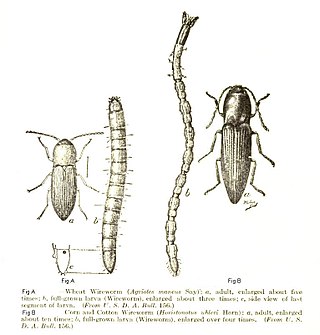
Elateridae or click beetles are a family of beetles. Other names include elaters, snapping beetles, spring beetles or skipjacks. This family was defined by William Elford Leach (1790–1836) in 1815. They are a cosmopolitan beetle family characterized by the unusual click mechanism they possess. There are a few other families of Elateroidea in which a few members have the same mechanism, but most elaterid subfamilies can click. A spine on the prosternum can be snapped into a corresponding notch on the mesosternum, producing a violent "click" that can bounce the beetle into the air. Clicking is mainly used to avoid predation, although it is also useful when the beetle is on its back and needs to right itself. There are about 9300 known species worldwide, and 965 valid species in North America.
Glowworm or glow-worm is the common name for various groups of insect larvae and adult larviform females that glow through bioluminescence. They include the European common glow-worm and other members of the Lampyridae, but bioluminescence also occurs in the families Elateridae, Phengodidae and Rhagophthalmidae among beetles; as well as members of the genera Arachnocampa, Keroplatus and Orfelia among keroplatid fungus gnats.

The Elateroidea are a large superfamily of beetles. It contains the familiar click beetles, fireflies, and soldier beetles and their relatives. It consists of about 25,000 species.

Pyrophorus nyctophanus, aka headlight beetle or carbunco, is a species of click beetle that occurs on the cerrado of Brazil. Its luminescent larvae are either soil-dwelling or found in tunnels in the outer layers of termite mounds, and are active predators of other insects during summer nights when their regulated glow acts as a lure to their prey. The adult beetles, though, are phytophagous, feeding on decomposing plant matter and exudates, and are attracted to artificial light. Pupae of this genus also luminesce.
"Headlight beetles are large click beetles notable among click beetles in their unique ability to produce light. An intense glow emanates from two round luminescent organs on the prothorax and a broad area on the underside of the first abdominal segment. In flight both sexes produce a brilliant blue-green streak of light that dazzles the onlooker." -Charles Leonard Hogue

Pyrophorus noctilucus, common name headlight elater, is a species of click beetle.

Pyrophorus punctatissimus is a species of click beetle.
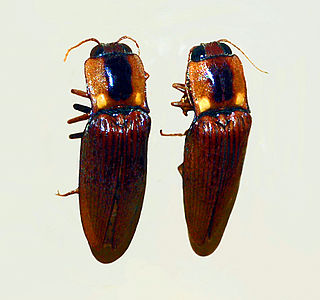
Pyrearinus candelarius is a species of click beetle.

Pyrearinus is a genus of click beetle.
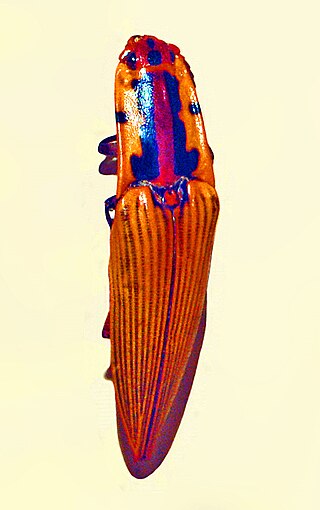
Semiotus is a genus of beetle belonging to the family Elateridae. It includes about 85 large sized (14–48 mm) and colourful click beetles with bright integument. The colouration is usually yellow with longitudinal black, orange or reddish stripes. The Neotropical genus occurs from Mexico to Argentina and Chile.
Cardiorhinus is a genus of click beetles in the subfamily Elaterinae.
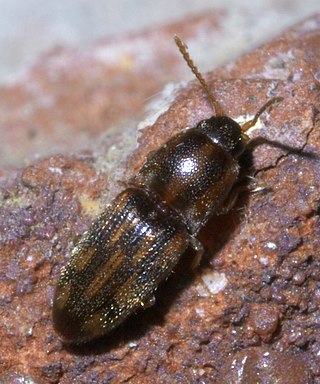
Monocrepidius is a genus of click beetles in the family Elateridae. The genus has often been cited as Conoderus, but of the two names for this genus published simultaneously in 1829, the one selected by the First Reviser under the ICZN was Monocrepidius, rendering Conoderus the junior synonym.

Elaterinae is a subfamily of click beetles in the family Elateridae, containing 12 tribes worldwide.
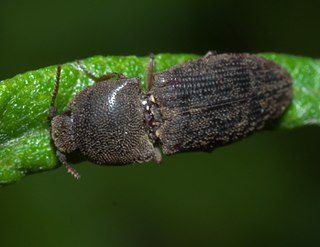
Agrypnini is a tribe of click beetles in the family Elateridae.

Agrypninae is a subfamily of click beetles in the family Elateridae. There are at least 130 genera and more than 430 described species in Agrypninae.
Deilelater is a genus of click beetle. They are one of several genera in the tribe Pyrophorini, all of which are bioluminescent. Most of the species were formerly in the genus Pyrophorus.
Vesperelater is a genus of click beetle. They are one of several genera in the tribe Pyrophorini, all of which are bioluminescent. Most of the species were formerly in the genus Pyrophorus.

The Pyrophorini are a New World taxonomic tribe within the Elateridae subfamily Agrypninae. Pyrophorini is a tribe of bioluminescent beetles, and includes such genera as Pyrophorus and Ignelater.
The Oophorini form an accepted taxonomic tribe within the Elateridae subfamily Agrypninae.

Ampedus is a genus of click beetles in the family Elateridae. There are currently 461 recognized species of Ampedus beetles. It has a cosmopolitan distribution, but is found mostly in the Holarctic region, primarily in North America, Europe, and Asia. The oldest known fossil from this genus was found in Eocene Baltic amber, estimated to be from 38.0–33.9 million years ago.

Dipropus is a genus of click beetles in the family Elateridae. There are around 150 described species in Dipropus, found in North, Central, and South America.













